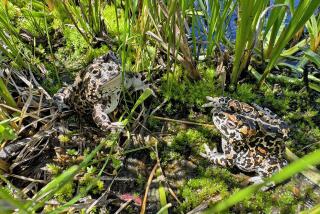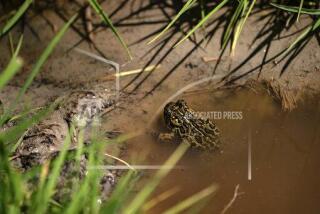Licking Toads Leaves More Than a Bad Taste in the Mouth : Trends: It may indeed be a ‘desperation high,’ but licking a toad is the latest way to hallucinate.
- Share via
SAN FRANCISCO — Licking toads will not give you warts or produce a fairy prince, but it might get you high.
It isn’t exactly an epidemic, but the Drug Enforcement Administration says toad licking is the latest way to hallucinate.
“It sounds like a fairy tale gone wrong, doesn’t it?” said Robert K. Sager, chief of the DEA’s laboratory in San Francisco. “Now, I don’t think this is going to be a great problem because people don’t go around licking toads as a habit.”
The culprit: the Cane toad.
“They’re beautiful toads,” Sager said. “People like them.”
The Cane toad, which can grow to the size of a dinner plate, produces a toxin called bufotenine, which the toad secretes to ward off predators. When licked raw or cooked, the toxin acts as a hallucinogen.
In the Southwest recently, several dogs have died after eating Cane toads, and the DEA has had bufotenine turn up at its research labs from time to time after drug arrests.
The green-and-red toads produce the same toxin that is found in amanita mushrooms, cohoba seeds and other plants. South American Indians have used the toxin for years in religious ceremonies because of its mind-altering qualities, and some tribes have used it in blowguns to kill dinner.
Bufotenine is considered a controlled, dangerous substance and is therefore illegal. However, it is not against the law to own a Cane toad, a favorite of aquarium aficionados.
“If you had a toad, we would have to prove you were licking it on purpose, or you had given it to someone to lick on purpose,” Sager explained.
The Cane toad has come into some renown in Australia, where four people died last year after partaking of its marbled flesh. (Depending on the size of the toad and the concentrations of toxin consumed, bufotenine can be fatal). The toad was imported to Australia from Hawaii in 1935 to kill the grayback beetle, which was destroying sugar cane in Queensland. The toad adapted beautifully, multiplied by the millions and ate everything--except for the beetle.
Last fall, officials in Brisbane, Australia’s third-largest city, announced an elaborate plan to eradicate the toads, which today pose a major threat to the continent’s fauna and wildlife.
In her book, “Cane Toads: An Unnatural History,” Stephanie Lewis describes a toad population so out of control that when she mows her lawn, she encounters “one cane toad to every two square meters,” leaving “all the trimmings of carcasses, guts and stench” in the cut grass.
(The problem also was the subject of an irreverent--and acclaimed--documentary. The film, titled “Cane Toads,” is in limited release.)
In recent years, toad licking has become popular in the Australian outback, prompting Queensland’s government to classify toad slime as an illegal substance under its Drug Misuse Act.
“That’s how this whole cycle started--a lack of dope in the Australian outback,” said Sager. “There, they are killing the toads, drying the skins and making tea. Yummy, huh?
“This is what you call a desperation high. It’s the sort of thing you do when you run out of dope,” he added. “It’s bizarre behavior. Man has always found ways to get (high), and he’s found some weird ways to do it.”
More to Read
Sign up for Essential California
The most important California stories and recommendations in your inbox every morning.
You may occasionally receive promotional content from the Los Angeles Times.










